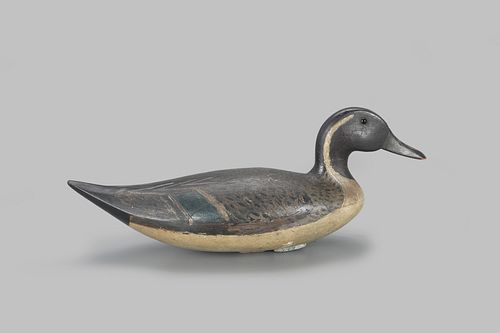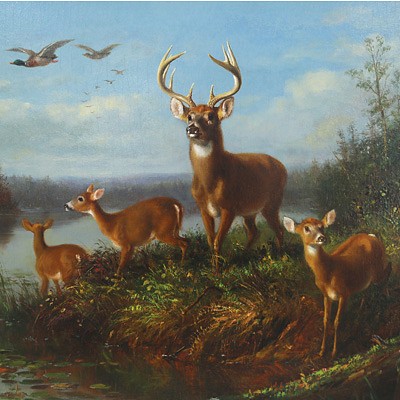Important Pintail Drake Decoy by Andrew A. Tull (1840-1915)
Lot 72
About Seller
Copley Fine Art Auctions
20 Winter Street
Pembroke, MA 02359
United States
Founded in 2005, Copley Fine Art Auctions is a boutique auction house specializing in antique decoys and American, sporting, and wildlife paintings. Over the course of the last two decades, the firm has set auction records for not only individual decoy makers, but also entire carving regions. Copley...Read more
Estimate:
$40,000 - $60,000
Absentee vs Live bid
Two ways to bid:
- Leave a max absentee bid and the platform will bid on your behalf up to your maximum bid during the live auction.
- Bid live during the auction and your bids will be submitted real-time to the auctioneer.
Bid Increments
| Price | Bid Increment |
|---|---|
| $0 | $50 |
| $1,000 | $100 |
| $2,500 | $250 |
| $5,000 | $500 |
| $10,000 | $1,000 |
| $25,000 | $2,500 |
| $50,000 | $5,000 |
About Auction
By Copley Fine Art Auctions
Feb 24, 2023
Set Reminder
2023-02-24 10:00:00
2023-02-24 10:00:00
America/New_York
Bidsquare
Bidsquare : The Winter Sale 2023, Day 1
https://www.bidsquare.com/auctions/copley/the-winter-sale-2023-day-1-11939
Lots 1-337 Copley Fine Art Auctions cinnie@copleyart.com
Lots 1-337 Copley Fine Art Auctions cinnie@copleyart.com
- Lot Description
Important Pintail Drake
Andrew A. Tull (1840-1915)
Philadelphia, PA, c. 1856
17 1/2 in. long
An exceptional Delaware River pintail drake, this example is a regional archetype quite distinct in form from other celebrated and later Delaware River pintail peers. This decoy is debuting in the modern decoy market after having resided in the Alberta Wingate family of Philadelphia for generations. Dating back to 1856 or prior, it is one of the earliest Philadelphia decoys known to exist.
The maker of this decoy has been inaccurately identified as John Blair by Henry Fleckenstein Jr. in his "New Jersey Decoys" book and by Harrison Huster and Doug Knight in "Floating Sculpture."
However, early decoy historians Bob White and Hal Sorenson were on the right trail when they discussed a closely related A Tull pintail in the 1977 "Decoy Collector's Guide," captioning, "This beautiful pintail drake from the lower Delaware River has "1856"stamped in the weight. It would well be a fore-runner to the "Blair"style." Fellow Delaware River decoy legend Kenneth Gosner in 1985 gravitated towards White and Sorenson's assessment when discussing an "A Tull" branded pintail in his Delaware River decoy treatise, writing, "obviously related to the Blair tradition and possibly predating the classic style."Research by noted Delaware River decoy collector Jeff Martinides follows White, Sorenson, and Gosner's beliefs as he points out that John Blair does not appear to land on the shores of America until 1865" almost a decade after an "A Tull 1856" decoy was stamped.
In 2014 Russ Allen lifted the veil on the Tull mystery when he researched a pattern-making family from the Kensington section of Philadelphia. Andrew J. Tull was the son of John P. Tull. The 1860 U.S. Federal Census Report lists Andrew as following in his father's footsteps as a pattern designer. Tull's occupation as a pattern maker explains the beautiful lines and exacting construction of this decoy.
Though research on Andrew Tull is still ongoing, we know that on January 18th, 1863, Andrew married Emma Mathews, also of Philadelphia. Shortly thereafter, on April 1, 1864, at the age of twenty-two, he enlisted in the U.S. Navy and served aboard the vessel "Chicopee" as a firefighter.
In reviewing this Tull pintail lot, its sleek, hollow body draws to a long and sharply pointed tail which resolves with crisp chines on both the top and sides. The raised neck seat secures a slightly forward-reaching head with refined bill and eye groove carving. The underside is fitted with two small lead weights, one with the region's classic chamfers. The body is finished with exceptional and dynamic feather painting with a tight craquelure patina. The lively and well-executed feather painting technique stands out in a city known for its fine plumage representations. The paint on this bird is by far the best found on any Tull.
L-shaped cut nails revealed in this decoy circa 1860 are rare, and typically only found in the finest and earliest decoys, including the dove-tailed decoys and Osgood geese.
Exceptional early gunning paint with even wear and a minor chip under the bill tip.
Provenance: Alberta Wingate Collection, Philadelphia
Robert Brown, Philadelphia
Private Collection by descent from the above
Literature: Hal Sorensen, "The Blair Mystery," Decoy Collector's Guide, 1977, p. 74, Tull pintail illustrated. Henry A. Fleckenstein Jr., "Decoys of the Mid-Atlantic Region," Exton, PA, 1979, p. 59, Tull decoy illustrated. H. Harrison Huster and Doug Knight, "Floating Sculptures: The Decoys of the Delaware River," Spanish Fork, UT, 1982, pp. 38-39, Tull decoys illustrated. Henry A. Fleckenstein Jr., "New Jersey Decoys," Exton, PA, 1983, p. 231, related Tull decoy illustrated. Russ Allen, "Arthur Bartholomew Vance and the Philadelphia School," Decoy Magazine, May/June 2014, pp. 2431, related Tull decoys illustrated. Hal Sorenson, "Decoy Collector's Guide,"1977, pp. 74-78, related Tull decoys illustrated. Kenneth L. Gosner, "Working Decoys of the Jersey Coast and Delaware Valley," Cranbury, NJ, 1985, p. 84, related Tull carvings illustrated.Please email condition report requests to colin@copleyart.com. Any condition statement given is a courtesy to customers, Copley will not be held responsible for any errors or omissions. The absence of a condition statement does not imply that the lot is in perfect condition.Condition
- Shipping Info
-
Shipping info
Copley does not offer in-house packing or shipping. For clients who require shipping, please complete the Shipping Release Form and return it with your payment. The form includes a list of shippers we frequently work with.
-
- Buyer's Premium



 EUR
EUR CAD
CAD AUD
AUD GBP
GBP MXN
MXN HKD
HKD CNY
CNY MYR
MYR SEK
SEK SGD
SGD CHF
CHF THB
THB














